by Élodie Lévèque and Louise O'Connor, Conservation; and Justin Furlong, Newspaper Librarian
The National Library of Ireland recently acquired two volumes of The Waterford Mirror containing rare issues from 1805 and 1806. In 1801, The Waterford Mirror and Munster Packet newspaper was first printed by John Bull, and from 1805 continued as The Waterford Mirror up to 1843. The only other libraries known to hold issues of The Waterford Mirror are the British Library and the Waterford Municipal Library. This newspaper was first set up for electioneering purposes to promote the interests of Sir John Newport and was printed three times a week. Sir John was a politician born in Waterford on 24th October 1756. He was created a baronet in 1789, and in 1802 Sir John entered Parliament as member for his native city. He acted in concert with the Whigs until 1832. After the passage of the Reform Bill he was appointed Comptroller of the Exchequer, from which office he retired in 1839, and he died at Newpark, near Waterford on 9th February 1843.
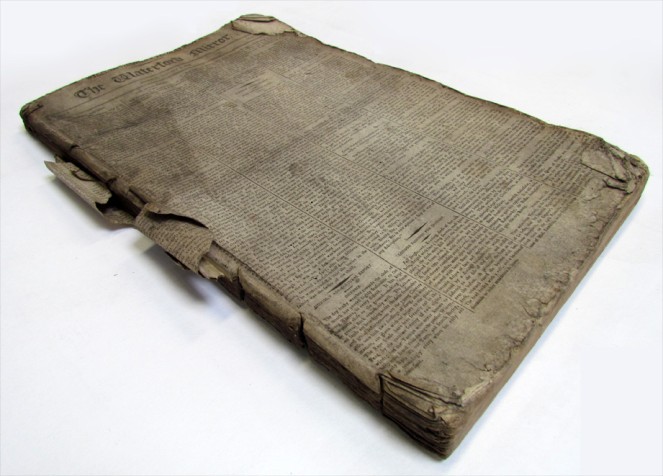
The Waterford Mirror before conservation
The history of the Irish press starts in Dublin in the second half of the 17th Century with very short-lived newspapers. During the first half of the 18th century, the press developed and about one hundred and fifty titles were produced in Dublin. At the beginning of the 19th century, newspapers were established in the larger provincial towns, like Waterford, where the first mention of printing press activity dates to 1729. Few copies of these newspapers exist today and the information contained within is greatly important for studies of the local and national activities of the 18th and 19th centuries.
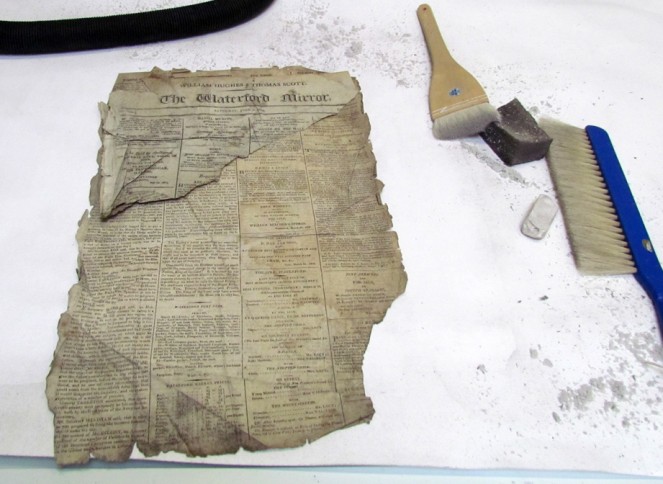
First step in treatment - dry cleaning with conservation erasers and soft brushes
As a long-time participant in the NEWSPLAN Project, we preserve newspapers through a microfilming programme that protects hardcopy holdings while making the content readily available to the public on microfilm. Prior to microfilming, these rare volumes of The Waterford Mirror were prioritised for conservation treatment due to their inappropriate binding structures which prevented easy opening and concealed text in the gutters. The condition of the volumes was too poor to allow safe handling or microfilming, and the first and last pages had extensive dirt deposits which obscured the text. It was therefore necessary to find an appropriate, quick, and reversible method for the paper repairs and re-binding.
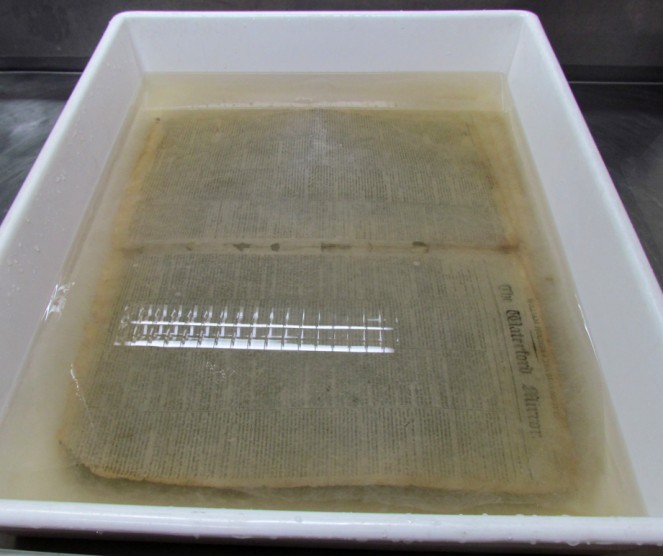
Washing The Waterford Mirror
Examination of the newspapers
In the 19th century binding newspaper issues together at the end of each year was common practice in libraries. Binding newspapers into large volumes maintained the sequence of the issues, prevented loss or theft of single issues and facilitated space-efficient vertical storage.
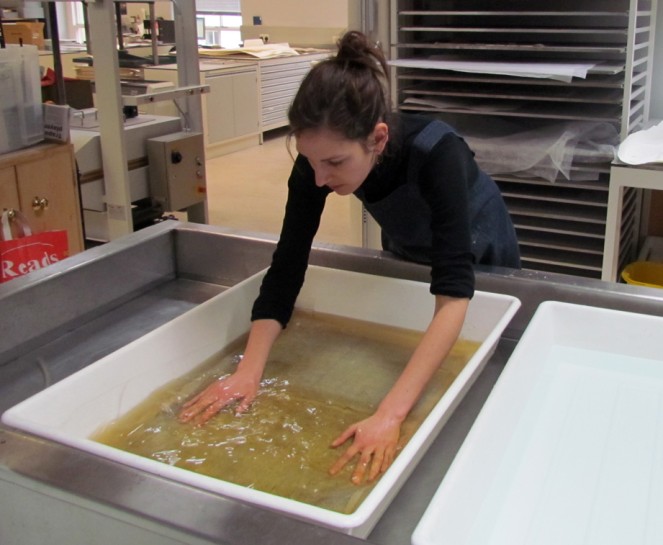
Élodie Lévèque washing The Waterford Mirror
The Waterford Mirror newspapers we have were bound in two separate volumes of sixty five pages and one hundred pages respectively. The restrictive binding structure was the main conservation issue, concealing the text along the gutter: the glue on the spine was very strong, stiff and dry, and the opening of the volumes was severely restricted. The volumes lacked any covering material, but the second volume had pieces of damaged leather glued directly to the spine.
The newspapers were printed with black carbon ink on a cream hand-made laid rag paper measuring approximately 480 x 305mm. The paper was extremely soft, possibly un-sized, and slightly discoloured. There was extensive surface dirt on the first and last pages. The ink was abraded, making the text illegible in some areas.
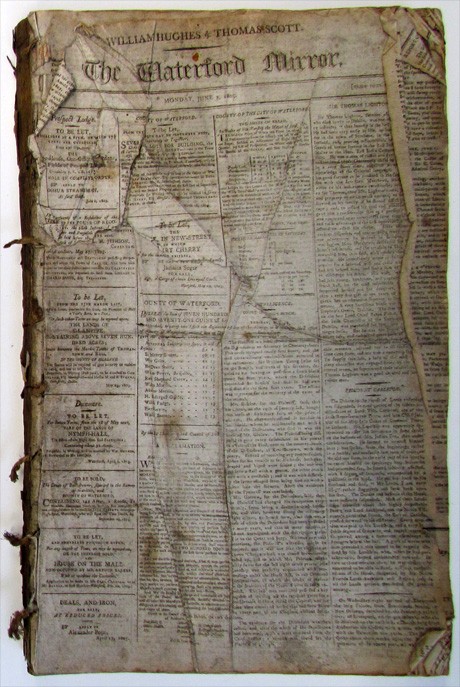
Before washing
Only fragments remained of the two first and two last pages of each volume, and several pages had significant losses and tears.
Conservation treatment
Surface cleaning was a very satisfactory step, and this also helped to considerably improve the clarity of the text. Each sheet was separated, and the entire textblock was washed in deionised water and calcium hydroxide.
The spine-folds of the sheets were locally repaired with Japanese Kozo paper and wheat starch paste. The losses and tears were infilled and strengthened by the use of pre-cut 2cm strips of lightweight Japanese paper which were adhered along the whole length of each spine-fold.
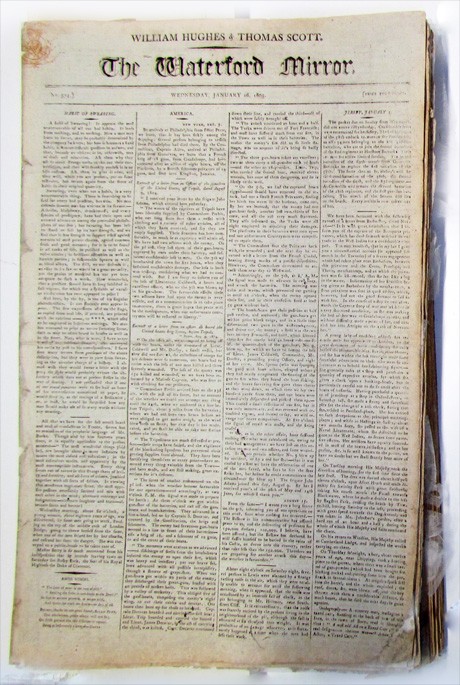
The Waterford Mirror after washing
As said above, binding into volumes has been frequently used for organising and storing newspaper issues. However, volumes of newspapers are difficult to handle due to their large format and weight. The vertical storage of large volumes can cause the text block to pull away from the binding, and the paper can tear along the spine-folds. Incoming newspapers are no longer bound here at the NLI, and are now routinely stored flat in archival boxes.
Therefore instead of choosing a traditional library-style binding, a flexible paper binding was found to be a more satisfactory treatment solution. This option keeps the original sequence of the issues along with any duplicates issues and also reflects the history of the volumes. We also decided to keep the current division of the volumes, as rebinding a hundred and sixty five issues together in one volume carried the risk of convex-curving at the spine which can result in paper damage along the foredge. Such a large volume would also be difficult to handle and store.
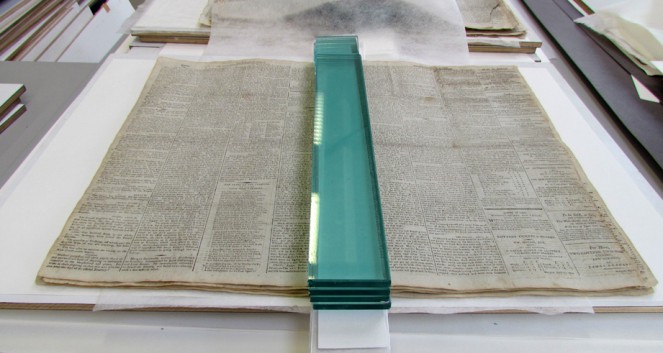
Drying of the Japanese paper repairs under weight
The rebinding had to be time-effective; provide reversible protection against poor handling; be secure enough to avoid losses in the future; and had to facilitate ease of opening - so this is the approach we took:
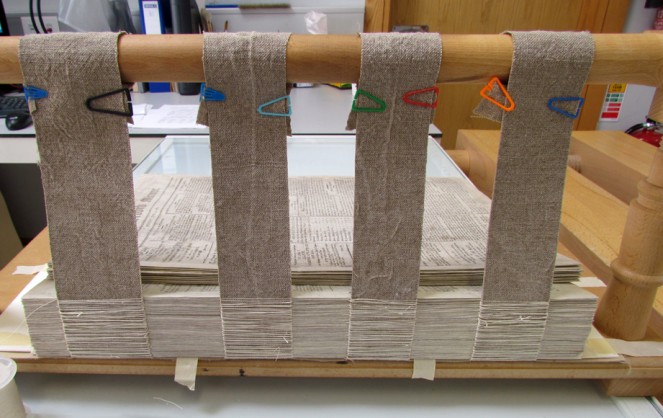
The sewing supports
- A Super Imperial 200gsm unbleached handmade paper was chosen to make the cover and the sewing supports.
- The cover/board was made of two distinct parts; the first part provides a support for the sewing and protects the foredge of the volume.
- The second part of the cover/board protects the sewing, forms the front board, and protects the foredge as it extends beyond the folios dimensions.
- The pages were sewn onto four supports.
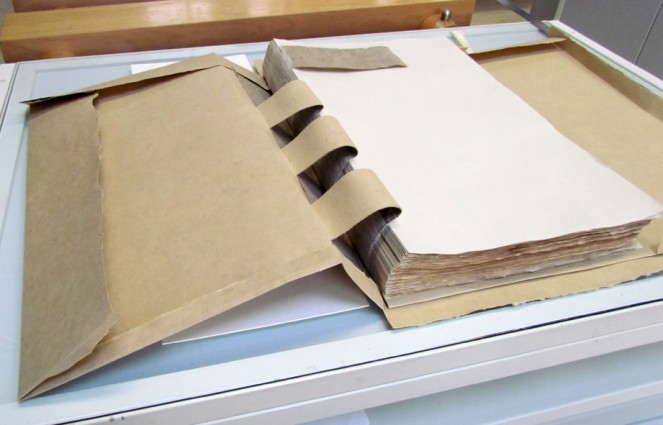
Assembling the new cover
After treatment, the book opened completely, and the text was clearly visible in the gutters of the sections.
Repairing damage to the spine-folds of a textblock is a very demanding and lengthy task. The standardised repair system adopted for these newspapers turned out to be a very fast and effective way to stabilise the paper sheets. A library cloth binding would not have been suitable for large single folios. As these items are not going to be regularly accessed after microfilming, a paper binding was found to be a cost-effective, fast and satisfactory solution which maintained the original structure idea. The two volumes are now stored horizontally on the library shelves in an archival box.
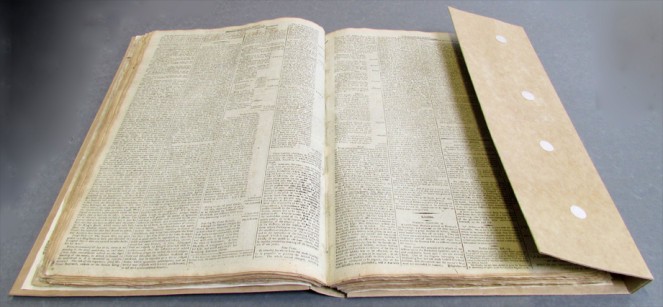
Our very rare early 19th century issues of The Waterford Mirror look very different following conservation treatment!
Following conservation treatment, these newspaper volumes were microfilmed, and now the microfilms of The Waterford Mirror are available to consult in our main reading room.
This post is a shortened version of an article publish in ICON News, (Institute of Conservation News) May 2012, issue 40.

